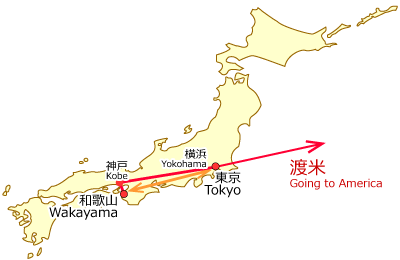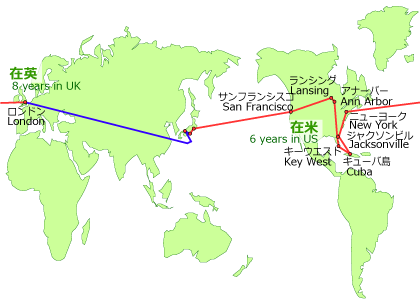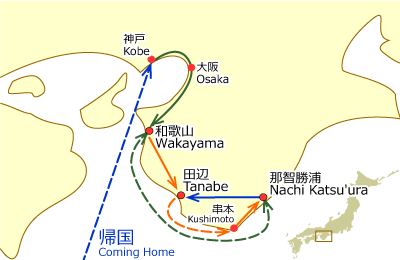 [1867]
[1867]
Born in Wakayama City
[1873]
Entered Ono Elementary School
[1879]
Entered Wakayama Middle School
[1884]
Entered Preparatory School, Tokyo University
[1886]
Departed from Yokohama for America (Dec)
 [1887]
[1887]
Arrived at San Francisco; entered Pacific Business College (Jan)
Transferred to Michigan State School of Agriculture (Aug)
[1891]
Moved to Jacksonville, Florida (Apr)
Discovered new species of lichen in Cuba
[1892]
Departed from New York for London
[1900]
Left London for Japan (Sep)

[1900]
・Departed from Kobe port to Wakayama (Oct)
[1901]
Departed from Wakayama city to Katsuura
Departed from Nachi to Wakayama city
[1902]
Departed from Wakayama city to Tanabe
Departed from Tanabe to Kushimoto
Leave for Nachi through Kozagawa Town
[1904]
Departing Nachi and leaving for Tanabe via Kumano kodo
| Year | Age | Personal Events | Historical Events |
|---|---|---|---|
| 1867 | 0 | Born in Wakayama City on April 15, the second son to Yahei and Sumi Minakata. | |
| 1873 | 6 | Entered Ono Elementary School. | |
| Started transcribing books; e.g. Wakan Sansai Zue, Honzo Komoku and Yamato Honzo, at the age of 10. | |||
| 1879 | 12 | Entered Wakayama Middle School. | |
| 1884 | 17 | Entered Preparatory School, Tokyo University. | |
| 1886 | 19 | Expelled from Preparatory School. | |
| Made a resolution to collect 7,000 specimens of Japanese fungi. | |||
| 1887 | 20 | Arrived at San Francisco; entered Pacific Business College. | |
| Transferred to Michigan State School of Agriculture. | |||
| 1888 | 21 | Moved to Ann Arbor, Michigan; collected animals and plants. | |
| 1889 | 22 | Determined to become Japan’s Gesner, the famous naturalist. | |
| 1891 | 24 | Moved to Jacksonville, Florida; contacted a lichen collector Calkins. | |
| Went to Cuba; discovered new species of lichens. | |||
| 1892 | 25 | Departed from New York for London. | |
| 1893 | 26 | Published ‘the Constellations in the Far East’ in the science magazine ‘Nature’ and won fame. |
|
| Became a regular visitor to the British Museum. | |||
| Transcribed rare books at the Museum until 1898 (totaling 52 notebooks; 13,346 pages). |
|||
| 1894 | 27 | Met Frederick V. Dickins, registrar of London University. | Outbreak of Sino-Japanese War |
| 1897 | 30 | Made friends with Sun Yat-sen. | |
| 1899 | 32 | Wrote the first article to ‘Notes and Queries,’ followed by a number of articles and essays. |
|
| 1900 | 33 | Left London for Japan. (Sep) | |
| 1901 | 34 | Met Sun Yat-sen again in Wakayama City. | |
| Revealed his concept of the universe Minakata Mandala in the correspondence with Horyu Toki. | |||
| 1904 | 37 | Left Nachi for Tanabe City. | Outbreak of Russo-Japanese War |
| 1905 | 38 | Co-translated ‘Hojoki: The Ten Square Feet Hut’ with Dickins. | |
| 1906 | 39 | Married Matsue Tamura. | |
| 1907 | 40 | Launched a campaign to protest against the shrine consolidation regulations. | |
| Started correspondence with Kunio Yanagita. | |||
| 1912 | 45 | Published an opinion letter about the shrine consolidation regulations to the magazine Nihon Oyobi Nihonjin (Japan and the People). |
|
| 1915 | 48 | Visited Kashima Island with Dr. Walton T. Swingle; turned down his invitation to US. |
Outbreak of WWI |
| 1917 | 50 | Discovered a new genus of slime mold Minakatella longifila Lister from a persimmon tree in his backyard. | |
| 1921 | 54 | Upon completion of the prospectus for the Minakata Botanical Institute project, came to Tokyo for fundraising. |
Great Kanto Earthquake (Sep 1) |
| 1925 | 58 | Sent a lengthy resume to Yoshio Yabuki. | |
| 1926 | 59 | Published Minakata Kanwa (idle chatter), Minakata Zuihitsu (a collection of essays) and Zoku Minakata Zuihitsu (the sequel). | |
| 1929 | 62 | Gave a special lecture to Emperor Hirohito on board the royal ship Nagato; presented him with 110 specimens of slime molds put in empty taffy boxes. (Jun) |
Outbreak of Manchurian Incident |
| 1941 | 74 | Died on December 29, aged 75. Buried at Takayamadera Temple in Tanabe City. | Outbreak of WWII (Dec 8) |
| After his death | |||
| 1963 | 22 | The monument of a poem composed by Emperor Hirohito was erected. It reads: “ Through the rain I see the dim figure of Kashima in the distance, which reminds me of Kumagusu who was born in Wakayama.” |
|
| 1965 | 24 | Minakata Kumagusu Museum opened in Shirahama-cho. | |
| 2000 | 69 | Daughter Fumie died. | |